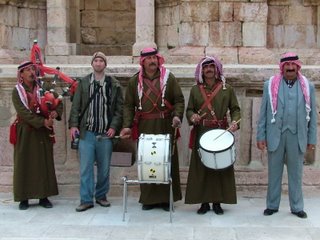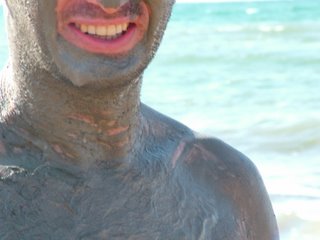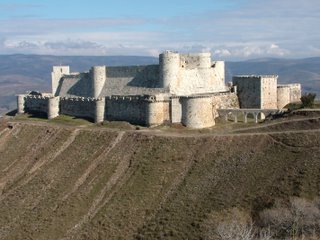
G'day,
On our final night in Damascus a few folks from the group headed to this little local cafe we'd been told about. One method of passing information from generation to generation is in the form of the oral tradition of storytelling, and while slowly dying out, there are some who still practice this art. For as long as anybody can remember, there is one old bloke who comes along to this one cafe every day from 5pm to 6pm and reads tales and folklore from a book in the old language of Aramaeic, and translates into Arabic for the audience. The five of us sat down in this cafe, ordered some tea and a sheesha pipe, and watched this guy perform. We were told by the waiter, that today it was one of the tales from the 1001 Arabian Nights. We didn't understand a word, but with his costume and sword as a prop he was as entertaining as anyone i've seen, and the audience interaction and repartee and laughter throughout was fantastic.

Damn we're moving at a frenetic pace. 6 days in Syria and then boom! - another new country, another stamp in the passport, and hey Presto. we're in Jordan!
Because a few of our group had some troubles getting visas before the trip started, our drive to Amman was split into two groups - one going straight thru with a change at the border, and the guide went with the 5 who needed visas on a seperate express mini-bus to get that issue all sorted out. That left the remaining 6 of us with no guide and some instructions to look out at the Syrian border for a tall, stocky, dark skinned man with tight curly hair (like that doesn't describe half the male Arab population!!) who was to be our driver from there to Amman. After completing passport/immigration formailities. We saw no sign of anyone that could have been our driver, and after an expensive international roaming mobile call to out hotel to try and suss out if they knew anything about it (they didn't), rather than be stuck at a Middle Eastern border post with no one to get us to our next stop, we decided to jump back on the public bus still sitting there.
At Amman a random guy ushered to his mini-bus and said he'd help us out. Somewhat confused, we refused, but then after overcoming the communication barrier, it turned out he was from the hotel. Obviously the driver had figured out what had happened and sent this guy. It turned out our driver had gone to the border to pick us up, but somehow we had simply missed each other (altho it beats me how he could miss 6 Westerners with chunky rucksacks wandering slightly befuddled around a border post!)
Speaking of guides, and drivers etc, I haven't made mention of our Syrian guide, Bashar. This guy has been simply incredible. In comparison to our Turkey guide (who was woeful) this guy was a revelation. An organisational supremo, he has turned out trip around. While the Turkey section was fun, there were times when it was frustrating beyond belief dealing with dodgy hotels with no heating or hot water in the midst of winter (and our guides inability to either ensure in advance this wouldn't happen, or resolve it in a satisfactory manner when it did). There were no such issues here, and moving thru a country like Syria, which is very much a police-state with potential dramas and dangers looming around every corner, he handled everything with aplomb. Having just said that tho, he was to be our guide for the Syria leg only - we've got a new guide to see us thru Jordan , and all the way thru Egypt to Cairo - an Aussie chick from Brisbane named Jodi, who also just happens to be a total babe!! But let's not get too distracted here!!
So anyway, we arrived in Amman a little weary, but in good shape. Now compare to the cities we have been thru recently, Amman doesn't really rate. It's pretty much just a big capital with a sprawling, but very densly packed metropolis of 1.6 million people (out of 5 million in the entire country), all, it seems, living virtually on top of one another in near identical light brown square-box-like housing, interspersed with a few 700-year old mosques on every 10th block. It, like Damascus, has its fair share of Palestinian refugees, and we noticed several very poor looking refugee camps on the outskirts of town on our way in. Aside from a few key sights there is not much in the way of historically or archaeologically important monuments, and we covered the main part of town in 1/2 a day of walking around.



I was beginning to suffer a little bit of information overload on ancient history anyways. After a while, all the facts and figures and dates and periods of a myriad of empires rising and falling tend to blend into each other, and i found myself getting confused pretty quickly, and not making sense of everything I was 'learning'. Not to mention the fact that more than few places we've visited are name-checked in the Bible and the Islamic Koran, which just magnifies their significance by some degree. There are a few serious history and archaeology buffs in our group, and they're soaking it all up like a sponge, checking out every single museum and ancient site they can.
That afternooon, we visited another Roman ruins site about an hour out of town, named Jerash. Very similar to Palmyra, the desert setting replaced with sprawling suburbia, and not as large. But while strolling around the site, we could hear Scottish bagpipes being played (of all things!!). Following our ears we wandered into the Amphitheatre and saw three Arab blokes dressed in the khaki uniform of the Scots Desert Patrol (a regiment posted there from early last century as i was reliably informed), playing pipes and drums!! They spoke no English and so we couldn't find out what their story was - how did they learn to play, where/how/why did they get the uniforms, and what they were doing there. The last question was answered by the open jewel box with small change in it - busking. But as strange and amazing and awesome as the moment was, we left none the wiser.

Talk soon.
Tonypeace love and happy faces























